Fitting to subsamples of Monte Carlo with the same statistics as the data sample will give a test of the reliability of
the
statistical error calculated for the fit. For the error to be
reliable 67% of the fitted coupling values should lie within one standard
deviation of the generated value. If this is true, then the
distribution of
![]() , where
, where ![]() is the fitted value of
the coupling,
is the fitted value of
the coupling, ![]() is the generated value and
is the generated value and ![]() is the statistical error on
is the statistical error on ![]() , should be a Gaussian with a width
consistent with unity.
These distributions are known as the pull distributions.
, should be a Gaussian with a width
consistent with unity.
These distributions are known as the pull distributions.
These tests were performed for all six couplings being measured, using both reweighting methods where applicable. Fits were not only made to Standard Model Monte Carlo but also samples with all the anomalous couplings used in the bias tests. A summary of the results is shown below.
Figure 6.7 shows the distributions of fitted values of the CP-conserving couplings. The fits were made to 139 Standard Model subsamples using the BILGOU reweighting scheme, and are for the combined fit result. The plots on the left just show the distributions and demonstrate that the fit is Gaussian and the mean is at the Standard Model value of the couplings. The width of this distribution can be taken as the expected statistical error on the measured value of the coupling. The plots on the right are the pull distributions. Figure 6.8 shows the distributions of the combined fit of the CP-conserving couplings, using the WVCXME reweighting scheme. For both reweighting methods the width of the pull distributions is close to unity for all couplings.
For both reweighting schemes, the fits for
![]() show a number of results with
a large deviation from the generated value of coupling. These generally
take a value
greater than
show a number of results with
a large deviation from the generated value of coupling. These generally
take a value
greater than
![]() =
=![]() 1. This is because the
1. This is because the
![]() distribution for
distribution for
![]() =
=![]() 2
is the same as that for the Standard Model. The plots of fits to just the
2
is the same as that for the Standard Model. The plots of fits to just the
![]() distribution for the CP-conserving couplings, using the BILGOU
reweighting scheme are shown in figure 6.9. For the fits
to
distribution for the CP-conserving couplings, using the BILGOU
reweighting scheme are shown in figure 6.9. For the fits
to
![]() it is obvious that a large proportion of the samples are mistakenly
fitted as
it is obvious that a large proportion of the samples are mistakenly
fitted as
![]() =
=![]() 2. A similar effect is seen to a lesser extent in the
2. A similar effect is seen to a lesser extent in the
![]() fits to
fits to
![]() , where the
, where the
![]() distribution at about
distribution at about
![]() =
=![]() 1 is
similar to that of the Standard Model.
1 is
similar to that of the Standard Model.
Figure 6.10 shows the distributions of the fitted values
of the CP-violating couplings for the combined fit using the BILGOU
reweighting scheme. The
distribution for
![]() does not appear Gaussian, and there is a bias
towards a coupling of zero. This is because any
anomalous CP-violating coupling will cause a flattening in the
does not appear Gaussian, and there is a bias
towards a coupling of zero. This is because any
anomalous CP-violating coupling will cause a flattening in the
![]() distribution. Due purely
to statistical fluctuations, a number of the subsamples will have
distribution. Due purely
to statistical fluctuations, a number of the subsamples will have
![]() distributions that are steeper than the Standard Model distribution. The
fits of the CP-violating couplings to these subsamples will immediately
be biased towards zero and the fits using just the
distributions that are steeper than the Standard Model distribution. The
fits of the CP-violating couplings to these subsamples will immediately
be biased towards zero and the fits using just the
![]() distribution
will all give a coupling value of zero. This obvious bias only manifests in the
distribution
will all give a coupling value of zero. This obvious bias only manifests in the
![]() fit and not those of the other two CP-violating couplings. This is
because the W production angle is much less sensitive to
fit and not those of the other two CP-violating couplings. This is
because the W production angle is much less sensitive to
![]() and
and ![]() than
than
![]() , so for these the SDM element fits completely
dominate in the combined fit results.
, so for these the SDM element fits completely
dominate in the combined fit results.
Figure 6.11 shows the distributions of the fit
of the CP-violating couplings to just the
![]() distribution.
It can be seen that in all coupling fits there is a
large spike at zero demonstrating the effect discussed.
distribution.
It can be seen that in all coupling fits there is a
large spike at zero demonstrating the effect discussed.
The pull distributions for the combined fit of
![]() ,
shown in figure 6.10, has a width much less than
unity, as would be expected. This then means that the width of the
distribution of fitted values cannot be taken as the expected error. For all
the CP-violating couplings the expected error has been taken as the mean value
of the statistical error from all the fits to the subsamples.
,
shown in figure 6.10, has a width much less than
unity, as would be expected. This then means that the width of the
distribution of fitted values cannot be taken as the expected error. For all
the CP-violating couplings the expected error has been taken as the mean value
of the statistical error from all the fits to the subsamples.
Table 6.9 shows the expected value of the statistical error that should be calculated in the fits to the OPAL data.
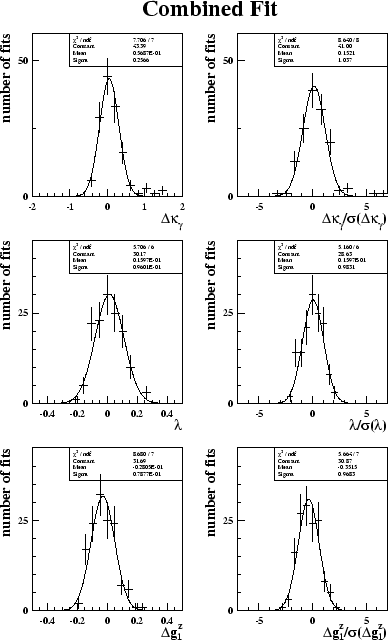 |
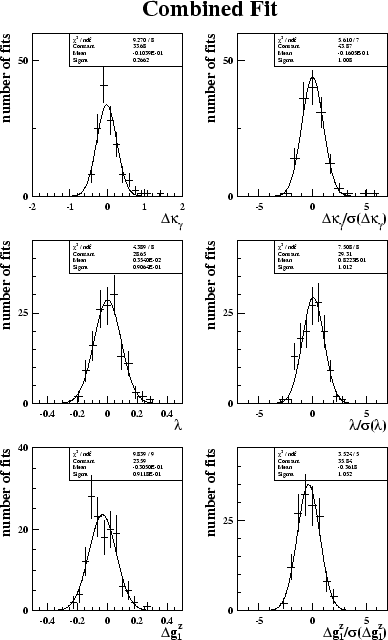 |
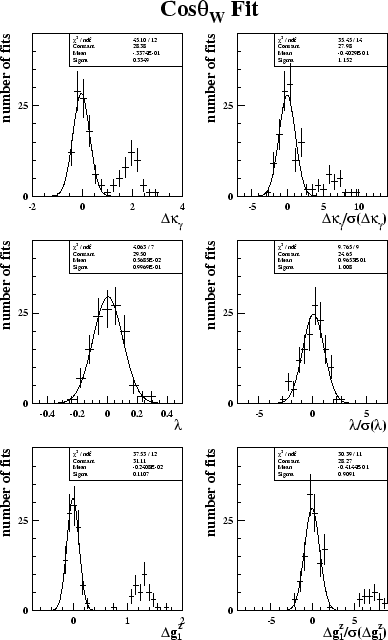 |
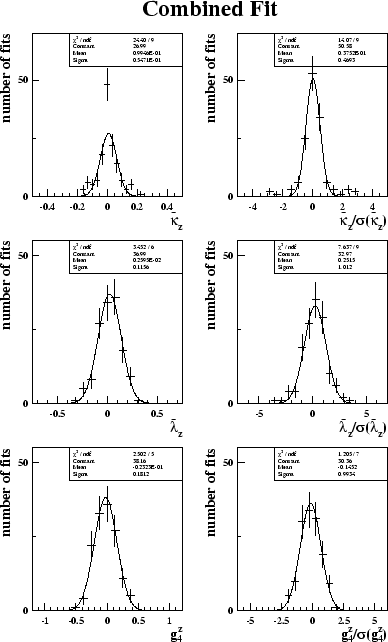 |
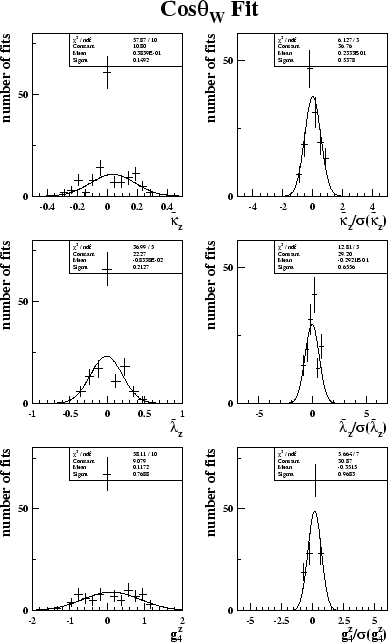 |